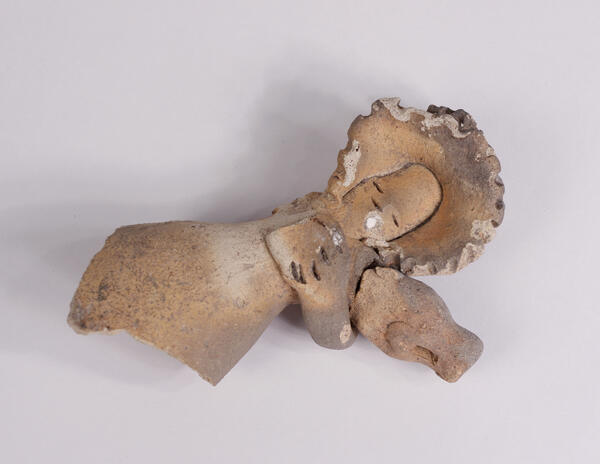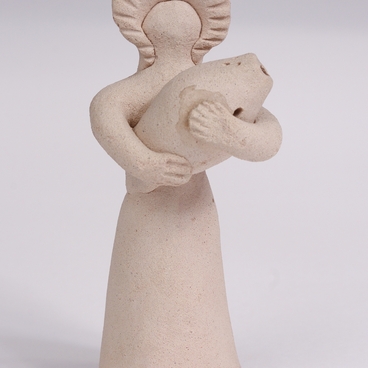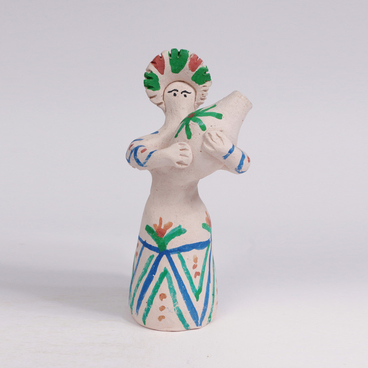Archaeologists found this figurine during excavations in the vicinity of Stary Oskol. Such toys continued to be popular among the locals for many centuries: the earliest female figure that has been discovered dates back to the 16th century. This figure was made around the 18th century.
In the past, potters called these figurines ‘baba’ (Russian name for a peasant woman). The female clay toy had several meanings. It symbolized soil fertility, immortality, ‘the beginning of all beginnings’, the guardian of the family and the hearth, the patron of women’s crafts.
Most often, old female figurines have a kokoshnik — it is “glued” to the heads of more than 93% of clay women. “Glued” means that the headdress was carefully attached to the toy — the wet clay ensured that the seam would be smooth and hardly visible.
The kokoshnik was a traditional headdress of a married woman. For the first time, it was mentioned in the 16th-century records. The name comes from the Old Slavic word “kokosh” meaning a chicken “hen”. Peter I, who cut the beards of his boyars, paid his attention to the kokoshnik as well — the ruler ordered noble women to stop wearing this headdress. It was not until the 18th century that the kokoshnik came back into use and was worn at the court — Empress Catherine the Great restored its popularity in line with the fashion of that time dictating the trend “a la russe”. The next time the kokoshnik enjoyed its peak popularity was during the Napoleonic wars and sometime after the victory over France, when there was a resurgence of patriotic sentiments. Until the 20th century, the headdress was fashionable among the common people and always worn at weddings.
The Stary Oskol clay kokoshniks usually consisted of several elements: an “ochelye” with “battlements”, a conical headpiece called “pozatylnik”, and a comb. The “ochelye” is a semicircular solid top part that rises above the forehead. The “battlements” are special ridges on the ochelye, which symbolize the ridges on fortress walls. The “pozatylnik” element resembled a cone-shaped cap, it was tied under the ochelye to cover the hair — u¬¬¬sually, there were two braids on the back of the head.
Some of the toys that have been discovered have traces of ochre paint on their clothes. However, there are no traces of paint on the headdresses of any figures.
In the past, potters called these figurines ‘baba’ (Russian name for a peasant woman). The female clay toy had several meanings. It symbolized soil fertility, immortality, ‘the beginning of all beginnings’, the guardian of the family and the hearth, the patron of women’s crafts.
Most often, old female figurines have a kokoshnik — it is “glued” to the heads of more than 93% of clay women. “Glued” means that the headdress was carefully attached to the toy — the wet clay ensured that the seam would be smooth and hardly visible.
The kokoshnik was a traditional headdress of a married woman. For the first time, it was mentioned in the 16th-century records. The name comes from the Old Slavic word “kokosh” meaning a chicken “hen”. Peter I, who cut the beards of his boyars, paid his attention to the kokoshnik as well — the ruler ordered noble women to stop wearing this headdress. It was not until the 18th century that the kokoshnik came back into use and was worn at the court — Empress Catherine the Great restored its popularity in line with the fashion of that time dictating the trend “a la russe”. The next time the kokoshnik enjoyed its peak popularity was during the Napoleonic wars and sometime after the victory over France, when there was a resurgence of patriotic sentiments. Until the 20th century, the headdress was fashionable among the common people and always worn at weddings.
The Stary Oskol clay kokoshniks usually consisted of several elements: an “ochelye” with “battlements”, a conical headpiece called “pozatylnik”, and a comb. The “ochelye” is a semicircular solid top part that rises above the forehead. The “battlements” are special ridges on the ochelye, which symbolize the ridges on fortress walls. The “pozatylnik” element resembled a cone-shaped cap, it was tied under the ochelye to cover the hair — u¬¬¬sually, there were two braids on the back of the head.
Some of the toys that have been discovered have traces of ochre paint on their clothes. However, there are no traces of paint on the headdresses of any figures.



